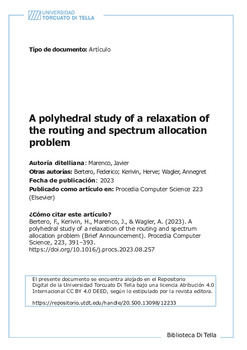| dc.rights.license | https://creativecommons.org/licenses/by-nc-nd/4.0/deed.es | es_AR |
| dc.contributor.author | Marenco, Javier | es_AR |
| dc.contributor.author | Bertero, Federico | es_AR |
| dc.contributor.author | Kerivin, Herve | es_AR |
| dc.contributor.author | Wagler, Annegret | es_AR |
| dc.date.accessioned | 2023-12-20T18:03:49Z | |
| dc.date.available | 2023-12-20T18:03:49Z | |
| dc.date.issued | 2023 | |
| dc.identifier.uri | https://repositorio.utdt.edu/handle/20.500.13098/12233 | |
| dc.identifier.uri | https://doi.org/10.1016/j.procs.2023.08.257 | |
| dc.description.abstract | The routing and spectrum allocation (RSA) problem arises in the context of flexible grid optical networks, and consists in routing
a set of demands through a network while simultaneously assigning a bandwidth to each demand, subject to non-overlapping
constraints. One of the most effective integer programming formulations for RSA is the DR-AOV formulation, presented in a
previous work. In this work we explore a relaxation of this formulation with a subset of variables from the original formulation,
in order to identify valid inequalities that could be useful within a cutting-plane environment for tackling RSA. We present basic
properties of this relaxed formulation, we identify several families of facet-inducing inequalities, and we show that they can be
separated in polynomial time. | es_AR |
| dc.format.extent | pp. 391–393 | es_AR |
| dc.format.medium | application/pdf | es_AR |
| dc.language | eng | es_AR |
| dc.publisher | Procedia Computer Science | es_AR |
| dc.publisher | Elsevier | es_AR |
| dc.rights | info:eu-repo/semantics/openAccess | es_AR |
| dc.subject | Routing and spectrum allocation | es_AR |
| dc.subject | Integer programming | es_AR |
| dc.subject | Facets | es_AR |
| dc.subject | Separation | es_AR |
| dc.title | A polyhedral study of a relaxation of the routing and spectrum allocation problem | es_AR |
| dc.type | info:eu-repo/semantics/article | es_AR |
| dc.type.version | info:eu-repo/semantics/publishedVersion | es_AR |

